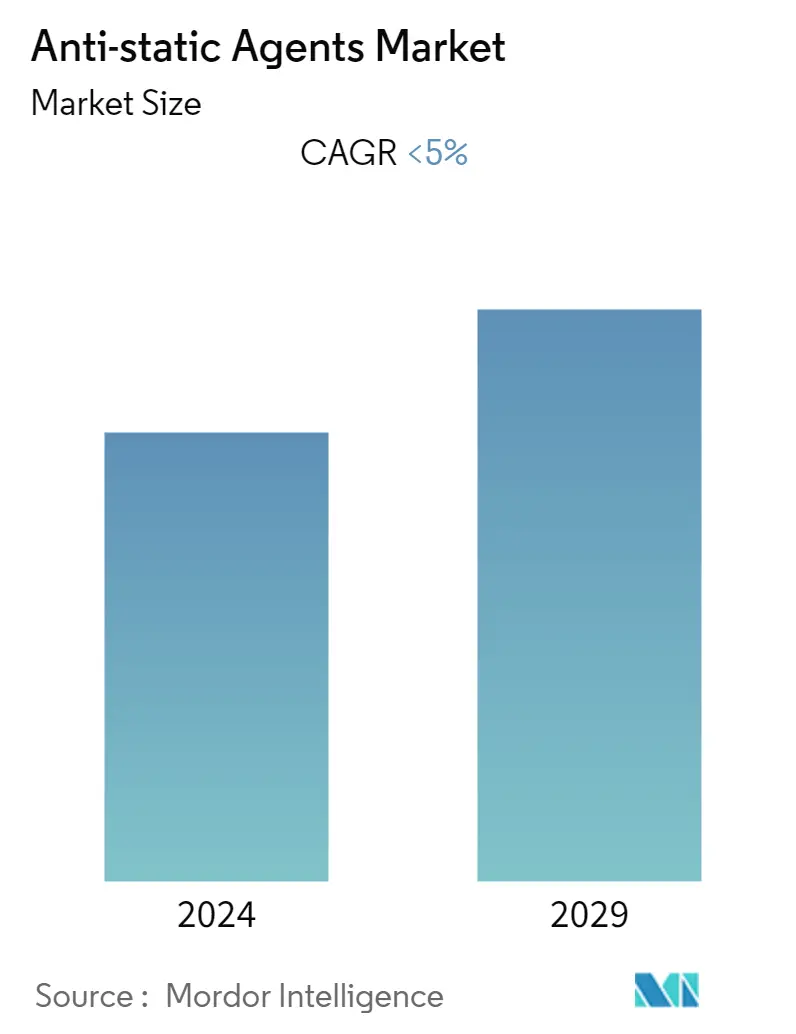Market Size of Anti-static Agents Industry

| Study Period | 2019 - 2029 |
| Base Year For Estimation | 2023 |
| CAGR | < 5.00 % |
| Fastest Growing Market | Asia Pacific |
| Largest Market | Asia Pacific |
| Market Concentration | Low |
Major Players*Disclaimer: Major Players sorted in no particular order |
Anti-Static Agents Market Analysis
The global anti-static agents market is expected to grow at a CAGR of around5% during the forecast period. Anti-static agents are added to plastics to reduce or eliminate a static build-up. Building up static charges on the plastic surface hampers the processing procedures and can be an issue for hygiene and aesthetics, hence anti-static agents are used in plastics as additives.
- Issues of static build-up in plastics and the growing demand for plastics from various end-user industries such as packaging, automotive, electronics, and medical is expected to be the driving factor in the market studied.
- Stringent government regulations by the FDA revoking the use of certain anti-static agents in food containers is expected to significantly hinder the growth of the market studied.
- Ethoxylated fatty acid amines is the majorly used anti-static agent and is expected to dominate the global market through the forecast period.
Anti-Static Agents Industry Segmentation
The global anti-static agents market includes:
| Type | |
| Monoglycerides | |
| Polyglycerol Esters | |
| Diethanolamides | |
| Ethoxylated Fatty Acid Amines |
| Polymer | |
| Polypropylene (PP) | |
| Polyethylene (PE) | |
| Polyvinyl Chloride (PVC) | |
| Others (ABS, polystyrene, etc.) |
| End-user Industry | |
| Automotive & Transportation | |
| Packaging | |
| Electronics | |
| Other End-User Industries (Medical, etc.) |
| Geography | |||||||
| |||||||
| |||||||
| |||||||
| Rest of the World |
Anti-static Agents Market Size Summary
The global anti-static agents market is poised for growth, driven by the increasing demand for plastics across various end-user industries such as packaging, automotive, electronics, and medical. Anti-static agents are essential additives used to mitigate static build-up on plastic surfaces, which can interfere with processing procedures and pose hygiene and aesthetic challenges. The packaging industry, in particular, holds a significant share of the market, with its expansion fueled by the fast-moving consumer goods sector and the burgeoning e-commerce industry. Despite the positive growth trajectory, the market faces challenges from stringent government regulations, particularly in the food sector, which restrict the use of certain anti-static agents. Ethoxylated fatty acid amines remain the dominant anti-static agent, expected to maintain its leading position throughout the forecast period.
In the Asia-Pacific region, the demand for anti-static agents is anticipated to rise significantly, supported by the robust growth of the plastics industry in countries like China. The region's burgeoning packaging industry, which contributes substantially to the GDP, is a major consumer of anti-static agents. The increasing disposable income and rising living standards in China have led to higher per capita consumption of plastics, further boosting production. Despite initial slowdowns due to international trade issues and geopolitical tensions, the market is expected to regain momentum later in the forecast period. The presence of both international and local players, such as 3M, Nouryon, BASF SE, Solvay, and Mitsubishi Chemical Corporation, adds to the competitive landscape, contributing to the market's partial fragmentation.
Anti-static Agents Market Size - Table of Contents
-
1. MARKET DYNAMICS
-
1.1 Drivers
-
1.1.1 Growing demand of plastics from various end user industries
-
1.1.2 Issues of static build up in plastics
-
-
1.2 Restraint
-
1.2.1 Stringent government regulations by the FDA revoking the use of certain anti-static agents in food containers
-
-
1.3 Industry Value-Chain Analysis
-
1.4 Porter's Five Forces Analysis
-
1.4.1 Bargaining Power of Suppliers
-
1.4.2 Bargaining Power of Consumers
-
1.4.3 Threat of New Entrants
-
1.4.4 Threat of Substitute Products and Services
-
1.4.5 Degree of Competition
-
-
-
2. MARKET SEGMENTATION
-
2.1 Type
-
2.1.1 Monoglycerides
-
2.1.2 Polyglycerol Esters
-
2.1.3 Diethanolamides
-
2.1.4 Ethoxylated Fatty Acid Amines
-
-
2.2 Polymer
-
2.2.1 Polypropylene (PP)
-
2.2.2 Polyethylene (PE)
-
2.2.3 Polyvinyl Chloride (PVC)
-
2.2.4 Others (ABS, polystyrene, etc.)
-
-
2.3 End-user Industry
-
2.3.1 Automotive & Transportation
-
2.3.2 Packaging
-
2.3.3 Electronics
-
2.3.4 Other End-User Industries (Medical, etc.)
-
-
2.4 Geography
-
2.4.1 Asia-Pacific
-
2.4.1.1 China
-
2.4.1.2 India
-
2.4.1.3 Japan
-
2.4.1.4 South Korea
-
2.4.1.5 Rest of Asia-Pacific
-
-
2.4.2 North America
-
2.4.2.1 United States
-
2.4.2.2 Canada
-
2.4.2.3 Mexico
-
-
2.4.3 Europe
-
2.4.3.1 Germany
-
2.4.3.2 United Kingdom
-
2.4.3.3 Italy
-
2.4.3.4 France
-
2.4.3.5 Rest of Europe
-
-
2.4.4 Rest of the World
-
-
Anti-static Agents Market Size FAQs
What is the current Anti-static Agents Market size?
The Anti-static Agents Market is projected to register a CAGR of less than 5% during the forecast period (2024-2029)
Who are the key players in Anti-static Agents Market?
3M, Nouryon, BASF SE, Mitsubishi Chemical Corporation and Solvay are the major companies operating in the Anti-static Agents Market.

